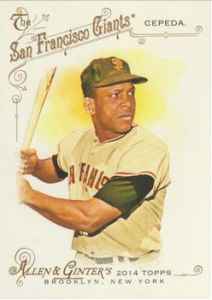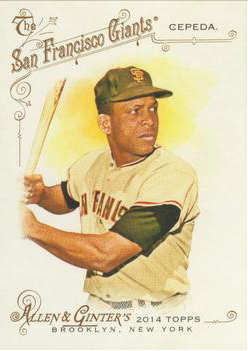April 30, 1957: Baby ‘Baby Bull’ Cepeda wows Minneapolis fans

Polled in the April 30, 1957, issue of the Minneapolis Tribune1 about the Minneapolis Millers’ prospects for the season, six fans split down the middle: Three were optimistic, two pessimistic, and one said it was too early to tell. (The Millers had played 13 games at the time, winning six.) The optimists were more correct, as the club placed third in the Triple-A American Association at 85-69. The pessimist who noted their lack of pop with the bat had a last laugh: They scored only six runs in four games in the first round of the postseason league playoffs and were swept by Denver.
More prescient yet was the fan who liked the look of 19-year-old first baseman Orlando Cepeda, who was making the jump from the Giants’ Class C affiliate at St. Cloud, Minnesota, to Minneapolis, the top of New York’s chain. The kid had started the season 1-for-18 but then had adjusted and was hitting .318, with power.2
The Millers’ immediate prospects were about to improve – the first-place Wichita Braves, who had just taken two of three, were leaving town, and the last-place Louisville Colonels, losers of eight of their first 10, were coming in.
Metropolitan Stadium had opened on April 24, 1956, on its Bloomington ex-cornfield, and with more cornfields still adjacent. Its seating capacity of 18,200 was a fraction of the 45,000 to which it would eventually be expanded,3 but the 2,325 who made the trip to the ’burbs on April 30, an unseasonably warm Tuesday night (80 degrees at the 8:00 P.M. game time), would find it spacious.
Millers starter Al Corwin was 30 years old and in the second, declining half of a professional career spanning 13 seasons. Unbeknownst to him, his big-league career, spent entirely with the Giants, had concluded in 1955 with a cumulative record of 18 wins and 10 losses in 117 games in which he pitched 289⅓ innings and posted a 3.98 earned-run average.4
Corwin had thrown a complete-game, 14-1 win at the Colonels the previous week in Louisville. His mound opponent, Marion “Murph” Murszewski, another minor-league vet, would shuffle between three stops in 1957, pitching only five games in Louisville before demotion to Double A.
Recent history was in this case a poor guide to predicting the course of the game of April 30. The Colonels roughed up Corwin. Clarence Moore’s leadoff triple in the first inning turned into a run when the outfield relay got away from Millers third baseman Jim Davenport. Three consecutive singles and a double-play grounder brought in two more in the second. A walk, a single, another triple by Moore, and a final single in the fourth finished Corwin. Murszewski meanwhile allowed only Don Grate’s solo home run through the first four.
Second baseman Wayne Terwilliger began the Millers comeback in the fifth, doubling home two, and two more in the sixth finished Murszewski’s night and cut the Millers’ deficit to one run. Reliever Harry Fisher surrendered the tying run in the seventh on a walk, a sacrifice, and a single before Cepeda homered over the 405-foot sign in center field, the deepest part of the ballpark. Joe Shipley, a 22-year-old making the jump from Class A Springfield (Massachusetts), was meanwhile in the course of four innings of shutout relief for the Millers.
Two more unsuccessful relievers allowed four more Millers runs in the eighth, two on another Terwilliger double, which perhaps allowed the veteran infielder to consider his two errors on the night as balanced out. Working with a 12-6 lead in the ninth, Shipley started the inning with a walk and a hit batsman, and both runners came in on a single and pair of infield outs before he closed out the inning and the game.5
With the Kentucky Derby coming up, the Louisville Courier-Journal of May 1 dolefully reported the blown lead but gave no space to commentary on the Colonels’ showing. The Minneapolis Star was naturally far more upbeat: “Millers Kids Star in Rally for 12-8 Victory,”6 referring to Shipley and Cepeda, with additional kudos for 25-year-old shortstop Ed Bressoud, who handled 11 chances and started three double plays. Staff writer Bob Beebe’s game summary dubbed Cepeda “Feets” (a shoe-size reference?) and noted that the young slugger now had three hits in the last week that gave the Millers late-inning leads. Columnist Charles Johnson was especially impressed with “Feets”:
“Orlando Cepeda boomed a line drive home run over the centerfield fence at Metropolitan stadium Tuesday night. It was one of the hardest hit balls smacked in the new plant. His batting performance on this occasion could become typical of his nightly efforts. He boasts tremendous brute strength. When he gets his bat on the ball, it travels. Last night’s home run fairly exploded.”7
With the Star also reporting that injured regulars Carlos Paula and Bob Schmidt were now fit to play, and that general manager Rosy Ryan expected the parent Giants to shortly send pitching help, all was on the upswing for the Millers.
Not everyone was a fan of Metropolitan Stadium, however, as the Star also reported. Bloomington’s streets were not ready for prime time:
“Steps to meet the traffic problem which develops in Bloomington when some 4,500 cars leave Metropolitan stadium at once are being studied by stadium and village officials. … The traffic problem at the new stadium is complicated because the suburb’s street program is in a rapid state of change and expansion.”8
Frequent complaints about stadium traffic from nearby residents produced promises by the village of Bloomington to upgrade and expand surrounding commercial avenues and protect residential streets with barriers, and by the stadium’s officials to provide information to fans on parking, streets, and exit routes.
Six springs after a 20-year-old Willie Mays had wowed Millers fans in his brief sojourn in a Minneapolis uniform, Cepeda, though the Giants decided he needed an entire Triple-A season under his belt, displayed the “can’t miss” talent that made him the 1958 National League Rookie of the Year.
Notes
1 “Just Ask: Do the Minneapolis Millers Look Like a Pennant Contender?” Minneapolis Tribune, April 30, 1957: 18.
2 Bob Beebe, “Cepeda’s Hitting Surge Bright Spot for Millers,” Minneapolis Star, April 30, 1957: 13B.
3 stadiumsofprofootball.com/stadiums/metropolitan-stadium/.
4 baseball-reference.com/players/c/corwial01.shtml.
5 Bob Beebe, “Colonels Blow Big Early Lead, Bow to Minneapolis 12 to 8,” Louisville Courier-Journal, May 1, 1957: Sec.2, 4.
6 Bob Beebe, “Shipley Earns More Work; Three ‘Wins’ for Cepeda,” Minneapolis Star, May 1, 1957: 1F.
7 Charles Johnson, “Lowdown on Sports,” Minneapolis Star, May 1, 1957: 1F.
8 “Solution Is Sought for Stadium Traffic,” Minneapolis Star, May 1, 1957” 1C.
Additional Stats
Minneapolis Millers 12
Louisville Colonels 8
Metropolitan Stadium
Bloomington, MN
Corrections? Additions?
If you can help us improve this game story, contact us.


